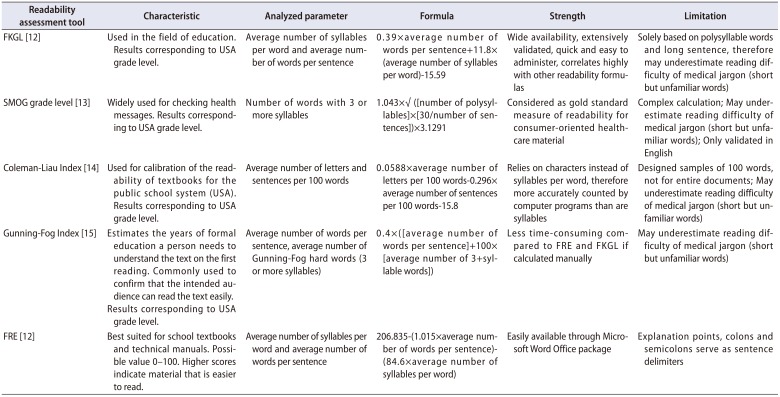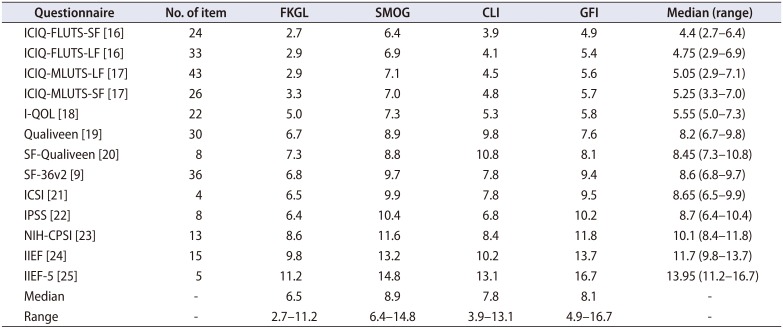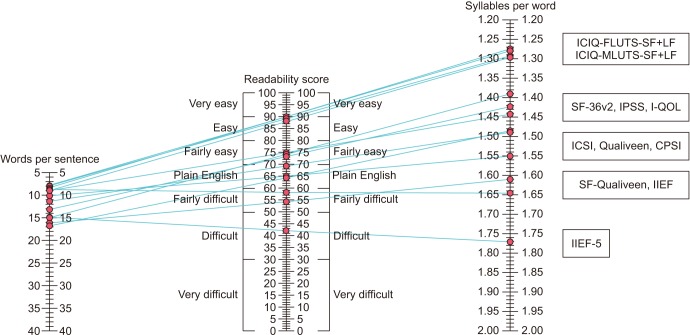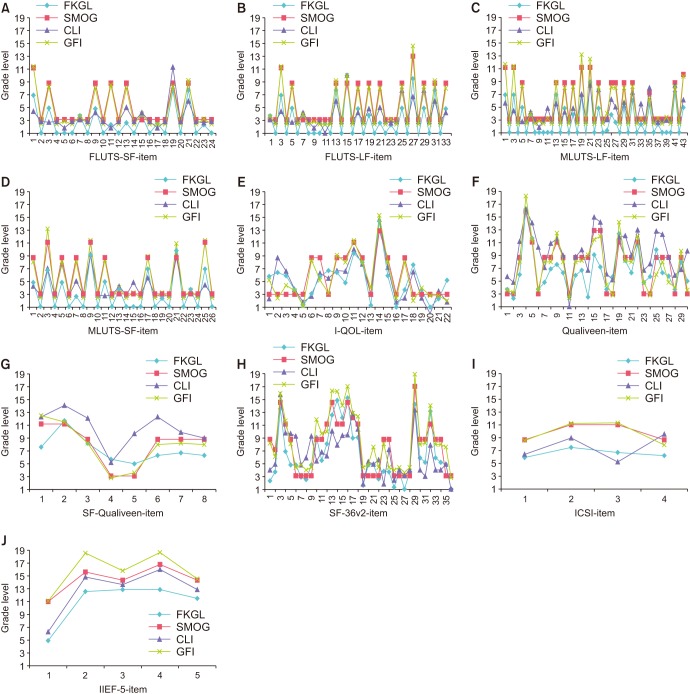1. Koo K, Yap RL. How readable is BPH treatment information on the internet? Assessing barriers to literacy in prostate health. Am J Mens Health. 2017; 11:300–307. PMID:
27903952.

2. Kasabwala K, Agarwal N, Hansberry DR, Baredes S, Eloy JA. Readability assessment of patient education materials from the American Academy of Otolaryngology--Head and Neck Surgery Foundation. Otolaryngol Head Neck Surg. 2012; 147:466–471. PMID:
22473833.

3. Medlineplus. How to write easy-to-read health materials [Internet]. Bethesda (MD): U.S. National Library of Medicine, U.S. Department of Health and Human Services National Institutes of Health;updated 2017 Jun 28. cited 2018 Jan 15. Available from:
https://medlineplus.gov/etr.html.
4. Weiss BD. Health literacy and patient safety: help patients understand. Manual for clinicians. 2nd ed. Chicago (IL): American Medical Association, American Medical Foundation;2007.
5. Bergman J, Gore JL, Singer JS, Anger JT, Litwin MS. Readability of health related quality of life instruments in urology. J Urol. 2010; 183:1977–1981. PMID:
20303519.

6. Atcherson SR, Richburg CM, Zraick RI, George CM. Readability of questionnaires assessing listening difficulties associated with (central) auditory processing disorders. Lang Speech Hear Serv Sch. 2013; 44:48–60. PMID:
23073668.

7. Alas AN, Bergman J, Dunivan GC, Rashid R, Morrisroe SN, Rogers RG, et al. Readability of common health-related quality-of-life instruments in female pelvic medicine. Female Pelvic Med Reconstr Surg. 2013; 19:293–297. PMID:
23982579.

8. Homan S, Hewitt M, Linder J. The development and validation of a formula for measuring single-sentence test item readability. J Educ Meas. 1994; 31:349–358.

9. Ware JE Jr, Sherbourne CD. The MOS 36-item short-form health survey (SF-36). I. Conceptual framework and item selection. Med Care. 1992; 30:473–483. PMID:
1593914.
10. Ware JE Jr. SF-36 health survey update. Spine (Phila Pa 1976). 2000; 25:3130–3139. PMID:
11124729.

11. Calderón JL, Morales LS, Liu H, Hays RD. Variation in the readability of items within surveys. Am J Med Qual. 2006; 21:49–56. PMID:
16401705.

12. Flesch R. A new readability yardstick. J Appl Psychol. 1948; 32:221–233. PMID:
18867058.

13. Hedman AS. Using the SMOG formula to revise a health-related document. Am J Health Educ. 2008; 39:61–64.

14. Coleman M, Liau TL. A computer readability formula designed for machine scoring. J Appl Psychol. 1975; 60:283–284.

15. Gunning R. The technique of clear writing. New York: McGraw-Hill;1952.
16. Brookes ST, Donovan JL, Wright M, Jackson S, Abrams P. A scored form of the Bristol Female Lower Urinary Tract Symptoms questionnaire: data from a randomized controlled trial of surgery for women with stress incontinence. Am J Obstet Gynecol. 2004; 191:73–82. PMID:
15295345.

17. Abrams P, Avery K, Gardener N, Donovan J. The International Consultation on Incontinence Modular Questionnaire: www.iciq.net. J Urol. 2006; 175:1063–1066. discussion 1066. PMID:
16469618.

18. Patrick DL, Martin ML, Bushnell DM, Yalcin I, Wagner TH, Buesching DP. Quality of life of women with urinary incontinence: further development of the incontinence quality of life instrument (I-QOL). Urology. 1999; 53:71–76. PMID:
9886591.

19. Bonniaud V, Parratte B, Amarenco G, Jackowski D, Didier JP, Guyatt G. Measuring quality of life in multiple sclerosis patients with urinary disorders using the Qualiveen questionnaire. Arch Phys Med Rehabil. 2004; 85:1317–1323. PMID:
15295759.
20. Bonniaud V, Bryant D, Parratte B, Guyatt G. Development and validation of the short form of a urinary quality of life questionnaire: SF-Qualiveen. J Urol. 2008; 180:2592–2598. PMID:
18950816.

21. Lubeck DP, Whitmore K, Sant GR, Alvarez-Horine S, Lai C. Psychometric validation of the O'leary-Sant interstitial cystitis symptom index in a clinical trial of pentosan polysulfate sodium. Urology. 2001; 57(6 Suppl 1):62–66. PMID:
11378052.

22. Barry MJ, Fowler FJ Jr, O'Leary MP, Bruskewitz RC, Holtgrewe HL, Mebust WK, et al. The American Urological Association symptom index for benign prostatic hyperplasia. The Measurement Committee of the American Urological Association. J Urol. 1992; 148:1549–1557. discussion 1564. PMID:
1279218.
23. Clemens JQ, Calhoun EA, Litwin MS, McNaughton-Collins M, Dunn RL, Crowley EM, et al. Rescoring the NIH chronic prostatitis symptom index: nothing new. Prostate Cancer Prostatic Dis. 2009; 12:285–287. PMID:
19488065.

24. Rosen RC, Riley A, Wagner G, Osterloh IH, Kirkpatrick J, Mishra A. The international index of erectile function (IIEF): a multidimensional scale for assessment of erectile dysfunction. Urology. 1997; 49:822–830. PMID:
9187685.

25. Rosen RC, Cappelleri JC, Smith MD, Lipsky J, Peña BM. Development and evaluation of an abridged, 5-item version of the International Index of Erectile Function (IIEF-5) as a diagnostic tool for erectile dysfunction. Int J Impot Res. 1999; 11:319–326. PMID:
10637462.

26. Steinbrook R. Searching for the right search--reaching the medical literature. N Engl J Med. 2006; 354:4–7. PMID:
16394296.
27. Walsh TM, Volsko TA. Readability assessment of internet-based consumer health information. Respir Care. 2008; 53:1310–1315. PMID:
18811992.
28. Mossanen M, Calvert JK, Wright JL, True LD, Lin DW, Gore JL. Readability of urologic pathology reports: the need for patient-centered approaches. Urol Oncol. 2014; 32:1091–1094. PMID:
24846343.

29. Dalziel K, Leveridge MJ, Steele SS, Izard JP. An analysis of the readability of patient information materials for common urological conditions. Can Urol Assoc J. 2016; 10:167–170. PMID:
27713791.

30. Kandula S, Zeng-Treitler Q. Creating a gold standard for the readability measurement of health texts. AMIA Annu Symp Proc. 2008; 353–357. PMID:
18999150.










 PDF
PDF ePub
ePub Citation
Citation Print
Print



 XML Download
XML Download